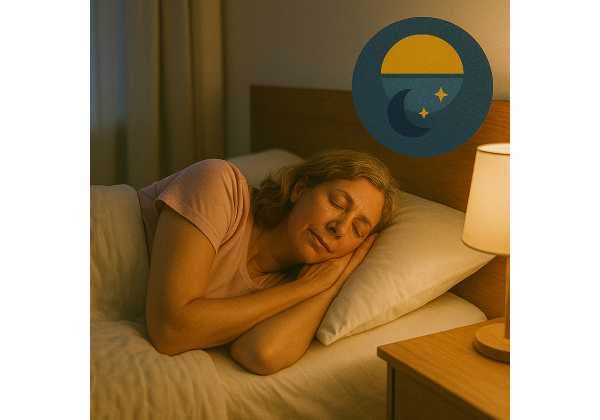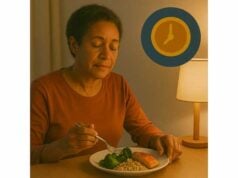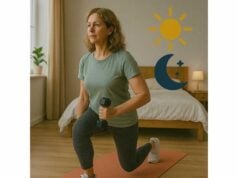
A reliable body clock is one of the simplest levers for better sleep, steadier energy, and long-term health. As we age, circadian signals can weaken: mornings feel sluggish, nights run later, and sleep fragments more easily. The fix is not complicated, but it does require intention. You need stronger daytime cues and gentler nights, anchored by a fixed wake time and a predictable morning routine. This guide turns circadian science into a practical plan you can run for two weeks and keep for life. You will learn which daily signals move your clock, exactly how to use morning light and evening dimness, how temperature and movement help, and how to time caffeine and melatonin. For a broader recovery playbook that complements these steps, explore our concise hub on sleep, stress, and recovery.
Table of Contents
- Major Zeitgebers: Light, Food, Activity, and Temperature
- Set Anchors: Fixed Wake Time and Consistent Morning Routine
- Light Exposure Plan: Morning Bright Light and Evening Dimness
- Temperature and Movement: Secondary Signals That Help
- Caffeine and Melatonin Timing: Do’s and Don’ts
- Jet Lag and Shift Work: A Step by Step Reset Strategy
- Tracking Progress: Sleep Efficiency, HRV, and Mood
Major Zeitgebers: Light, Food, Activity, and Temperature
Your circadian system is a network of clocks. The master pacemaker in the brain reads environmental time, while peripheral clocks in the liver, gut, muscle, and fat respond to behavior. The signals that set (“entrain”) these clocks are called zeitgebers—literally “time givers.” For everyday life, four dominate:
- Light: The most powerful cue. Light in the morning advances the clock; light at night delays it. Intensity, spectrum, duration, and timing all matter. Daytime brightness keeps your internal day robust; evening dimness protects the transition to sleep. Think of light as the steering wheel.
- Food: Timing your first and last calories helps peripheral clocks align with the master clock. Earlier, consistent meals—especially a substantial breakfast or lunch—reduce evening hunger and make earlier bedtimes easier. Late, heavy dinners keep your temperature and glucose high, which delays sleep.
- Activity: Movement is a supportive cue. Morning or daytime activity pairs well with bright light to strengthen daytime alertness. High-intensity workouts very late can push the clock later; gentle evening movement (walks, stretching) is usually sleep-friendly.
- Temperature: Your body runs warmer by day and cooler at night. Evening cooling—lighter meals, dim light, a cooler bedroom—supports the normal drop that invites sleep. Hot baths or showers early in the evening can help by driving a rebound cooling afterward.
When these signals point in the same direction—bright mornings, earlier meals, daytime movement, cooler and darker nights—sleep consolidates and timing stabilizes. When they conflict—dim days, blue-bright nights, late large dinners—sleep drifts, deep stages shrink, and daytime energy wobbles. The practical goal is consistency: the same set of cues at about the same times every day, with small, intentional adjustments when life gets messy.
Set Anchors: Fixed Wake Time and Consistent Morning Routine
If you change only one habit, set a fixed wake time and defend it seven days a week. Waking at a consistent clock time stabilizes the anchor point your body uses to organize appetite, hormones, and sleep drive. It also makes every other tool—light, activity, meals—more effective.
Build a morning routine that fires the same cues in the same order:
- Light within an hour of waking. Get outdoors if you can; if not, seek bright indoor light (open curtains fully and use the brightest room). Two short 5–10 minute exposures early beat none.
- Move the body. A brisk walk, mobility flow, or a few flights of stairs turns on metabolism and primes attention. If you train hard, mornings or midday are generally friendlier to sleep than late evening.
- Eat your first calories on time. A balanced breakfast (or an early substantial lunch if you prefer a later first meal) helps move hunger earlier, which makes earlier dinners natural.
- Tame early screens. If news and email spike stress, delay them by 15–30 minutes while you take light and move. This small buffer prevents a cortisol surge from becoming your first zeitgeber.
For many readers, a two-week anchor plan works well:
- Weekdays: Fixed wake time (±15 minutes), outdoor light within 60 minutes of waking, and a consistent first meal time.
- Weekends: Keep wake time within one hour of weekdays. If you stay up later, resist the “catch-up” sleep-in; use a short afternoon nap instead.
If you also want a simple way to reduce cognitive arousal at night, pair this anchor with a brief breathwork routine. Our practical primer on paced breathing for sleep shows how five minutes can smooth the transition to bed.
Light Exposure Plan: Morning Bright Light and Evening Dimness
Light is the master switch. To reset timing and protect sleep architecture, treat light like a daily prescription.
Morning (advance the clock, boost alertness)
- Dose: Aim for 30–60 minutes of outdoor light within the first hour after waking. Cloudy day? Stay out a little longer. If outdoors is impossible, work near a bright window or supplement with a high-output indoor light source during the first part of your morning.
- Distance and direction: Eyes open, looking toward the illuminated environment (not at the sun). Sunglasses reduce effect; use them only if needed for comfort and safety.
Midday (maintain the signal)
- Seek additional daylight breaks (10–20 minutes). They help sustain mood and alertness and keep the internal day robust.
Evening (protect the descent)
- Dimming: Two hours before bed, transition to warm, low-level light. Replace overheads with shaded lamps at or below eye level.
- Screens: Treat screens like lamps. Lower brightness to the minimum comfortable, increase text size, and enable warm-tone night settings. Keep devices at least 50–70 cm from your eyes.
- Content: Choose low-arousal media. If you feel wired despite warm, dim settings, the issue may be content, not color.
- Night awakenings: Use path lights aimed at the floor; avoid ceiling lights. Do not unlock your phone—the bright, interactive blast is a clock nudge you do not want.
If you need deeper cuts on device tactics (auto-dimming, grayscale, and notification control), our hands-on guide to evening screen hygiene offers practical setups that stick.
Finally, remember that morning light advances and late-night light delays. When your schedule drifts, adjust those two levers first. Consistency over weeks—not one perfect night—makes the change durable.
Temperature and Movement: Secondary Signals That Help
After light, temperature and movement provide strong supporting cues. They are also easy to program into a home routine.
Temperature, timing, and sleepiness
Your body’s core temperature follows a daily curve: highest in late afternoon, lowest in the second half of the night. Sleepiness increases as core temperature falls. Lean into that physics:
- Earlier evening cooling: Finish larger meals 3–4 hours before bed so digestion does not hold temperature up. Keep the bedroom cool (often 17–19 °C works well) and the bed comfortably warm with breathable layers.
- Warm early, cool late: A warm bath or shower 1.5–2 hours before bed causes a rebound cooling that eases sleep onset.
- Night sweats/hot flashes: Use breathable bedding, a bedside fan, or a cooling pad during symptomatic periods. Keep a small glass of room-temperature water nearby to reduce trips.
Movement as a clock cue
- Daytime: Regular activity—especially outdoors with light—strengthens daytime alertness and improves mood.
- Late evening: Reserve high-intensity work for earlier; vigorous exercise in the last 2–3 hours before bed can make timing slip later in sensitive sleepers.
- Gentle wind-down: Light stretching, a walk after dinner, or 5–10 minutes of slow breathing pulls arousal down without jolting the clock.
Meals as temperature and timing tools
- Heavier, higher-fat dinners digest slowly and can run “hot.” When dinner must be late, make it lighter and cooked, and taper fluids in the final 2 hours to reduce awakenings. For step-by-step meal-timing guidance that meshes with circadian goals, see our concise guide to chrononutrition.
Small environmental cues accumulate. A home that gets bright and active by day and dim and cool by night teaches your nervous system when to be alert and when to let go—without white-knuckle willpower.
Caffeine and Melatonin Timing: Do’s and Don’ts
Two common tools—caffeine and melatonin—push your timing in opposite directions. Use them on purpose.
Caffeine: morning ally, evening enemy
- Cutoff: Because caffeine’s half-life often runs ~5 hours (and longer for some), a practical 8–10 hour cutoff before bedtime protects sleep architecture. Sensitive sleepers often need 10–12 hours.
- Front-load: Take most caffeine in the first half of the day. Many people feel steadier with a 60–90 minute delay after waking before the first dose, letting natural cortisol rise do its job.
- Dose discipline: Split smaller doses rather than one large late shot, and avoid “rescue” caffeine after mid-afternoon.
Melatonin: a clock cue, not a knockout pill
- Use-case: Best for shifting timing—jet lag, delayed sleep phase—or as a gentle nudge during schedule resets.
- Dosing: Small amounts often work (e.g., 0.3–1 mg). Higher doses are not necessarily better for phase-shifting and can cause grogginess.
- Timing: For most delayed sleepers advancing bedtime, take melatonin 3–5 hours before desired sleep time, then seek bright morning light. For jet lag, timing depends on direction; see the step-by-step plan below.
- Consistency: Use for several days while you apply strong light cues; then taper.
If evenings out include alcohol or late, heavy food, those will overpower both caffeine rules and melatonin timing. To protect sleep on social nights, shift drinks earlier, keep dinner lighter, and maintain a cool, dark bedroom. For more on how stimulants and late meals interact with sleep stages, see our practical overview of evening timing rules.
Jet Lag and Shift Work: A Step by Step Reset Strategy
Disrupted schedules unravel timing cues. The fix is a short protocol that sequences light, melatonin (optional), meals, and caffeine. Here is a field-tested plan you can adapt.
For eastbound travel (you need to fall asleep earlier)
- 3–4 days before: Shift wake, light, and meals earlier by 30–60 minutes/day. Move caffeine earlier; stop earlier.
- Melatonin (optional): Start 0.3–1 mg 4–5 hours before current bedtime for 2–3 nights pre-trip.
- On arrival: Get bright morning light (outdoors if possible). Keep the first local dinner light and early. Avoid late-evening screens and alcohol for the first two nights.
For westbound travel (you need to stay up later)
- 3–4 days before: Shift wake, light, and meals later by 30–60 minutes/day.
- Caffeine: A small late-afternoon dose (still outside your personal cutoff relative to the new local bedtime) can help stretch the evening.
- On arrival: Seek late-afternoon light and keep the first local breakfast small if you arrive at predawn; focus on local lunch and local dinner instead.
On planes
- Light: Use eye shades when you plan to sleep; keep screens dim.
- Fluids: Hydrate, but taper before planned sleep to reduce awakenings.
- Meals: Align with destination time—avoid large plane dinners right before a planned onboard sleep.
For night shifts
- Light: Use bright light during the first half of the shift; block morning light (dark glasses) on the commute home; keep the sleep environment dark and cool.
- Caffeine: Front-load early in shift; stop 6–8 hours before planned sleep.
- Melatonin (optional): Low-dose melatonin 30–90 minutes before daytime sleep can help some, but prioritize darkness and noise control first.
- Meals: Main meal before the shift; very light snack during the circadian night (02:00–04:00); small protein + complex carb before bed to avoid waking hungry.
For a deeper dive that merges light maps and timing tables across time zones and schedules, see our practical guide to jet lag and shift work strategies.
Tracking Progress: Sleep Efficiency, HRV, and Mood
Resets work when you can see change. Track a few simple outcomes for two weeks as you apply the plan.
1) Sleep timing and efficiency
- Record bedtime, sleep latency (estimate), awakenings, and wake time. Sleep efficiency is total sleep time divided by time in bed; aim for ≥85% most nights. Expect a few rough nights as you shift; judge by weekly trends.
2) Daytime function
- Each morning, rate energy and mood on a 1–5 scale during the first two hours after waking. Stable mornings and fewer mid-afternoon dips are good signals that timing is aligning.
3) HRV and resting heart rate (optional)
- If you use a wearable, track resting heart rate and overnight HRV as broad trend indicators. Expect noise with travel, alcohol, illness, or intense training days. Do not chase single-night changes.
4) Light and meal logs (brief)
- Note morning light minutes and last meal time. These two behaviors explain a surprising amount of sleep variability.
Run a mini-experiment
- Week 1 (observe): Keep your routine; log sleep and anchors.
- Week 2 (intervene): Fix wake time; add morning outdoor light; move dinner 3–4 hours before bed; dim and warm evening light; maintain a cool bedroom; respect caffeine cutoff. Compare outcomes.
If progress stalls
- Slide light earlier (or later) by 30 minutes depending on whether you need to advance or delay.
- Audit evening light leaks (overheads, bright bathrooms, phones in bed).
- Re-check caffeine and alcohol timing—they often masquerade as “insomnia.”
For help deciding which wearable metrics matter and which to ignore, our practical primer on using wearables wisely can keep your focus where it counts: behaviors that move the clock.
References
- Predicting melatonin suppression by light in humans (2022)
- Treatment of Circadian Rhythm Sleep–Wake Disorders (2022)
- Pharmacological interventions for jet lag (2021)
- Light at night and circadian rhythms: from the perspective of the circadian clock (2024)
- Effects of light on human circadian rhythms, sleep and mood (2019)
Disclaimer
This article is educational and is not a substitute for professional medical advice, diagnosis, or treatment. Changing light exposure, caffeine, melatonin, and meal timing can affect sleep, blood pressure, glucose control, and medication needs. Consult a qualified clinician if you have insomnia, mood disorders, cardiovascular or metabolic disease, eye disease affecting light sensitivity, or if you plan to use melatonin while on prescription medicines. If sleep problems persist for several weeks or impair daytime function, seek clinical evaluation.
If this guide helped you, please consider sharing it on Facebook, X (formerly Twitter), or any platform you prefer, and follow us for future updates. Your support helps us continue creating clear, practical resources on sleep and healthy aging.










